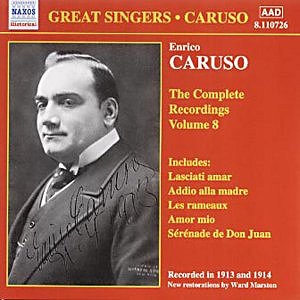Caruso was one of the few great singers of his time whose recordings
made him famous in homes all over the world. In 1901 shellac discs replaced
wax cylinders and records could be mass-produced. Playing times for
ten-inch records were about three minutes, but shellac is easily damaged
by steel needles; all the more remarkable, therefore, that today we
can hear such treasured performances as those on this newly registered
CD transfer, not, of course, to present-day standards, but nevertheless
impressive enough. Surface noise is rarely obtrusive and, though the
orchestra sounds predictably feeble, at 40 Caruso’s voice has retained
a youthful, virile quality that makes this disc a remarkable achievement,
and well worth its budget price. Singers who risked the cramped conditions
and unreliable technology of early recording studios had to be prepared
to modify their interpretations to suit the recording equipment, and
there are moments where, on stage, Caruso would surely have given more
spacious interpretations.
On track one, Leoncavallo’s Lasciati amar, the
excessive portamento tenors used to use to stir their audiences is rather
obtrusive, but these pieces, all less than five minutes in length, display
a voice that thrilled even wider audiences than today’s idols. (In a
recent article in the Sunday Telegraph the music critic Alexander
Chancellor judged Pavarotti’s operatic career as being "almost
as glorious as Caruso’s"). Virtually all these recordings exploit
the accurate, steady, unforced upwardly extended range of Caruso’s voice
(C-sharp and higher!) especially impressive in the O’Hara and Rossini
excerpts. There are two interpretations of Faure’s Les rameaux on
this disc, the first released only in Europe, the second being made
for release in both Europe and the USA. Both reveal Caruso’s subtlety
of phrasing, but for me the most impressive track is the short excerpt
from Verdi’s Otello where, matched with the magnificent baritone
Tita Ruffo as Iago, the duet rises to an impassioned intensity that
overcomes the age and technical limitations under which it was made.
Those who have found much to admire in the forerunners
of this worthwhile project will need no encouragement to acquire the
latest addition to the series.
Roy D.Brewer


